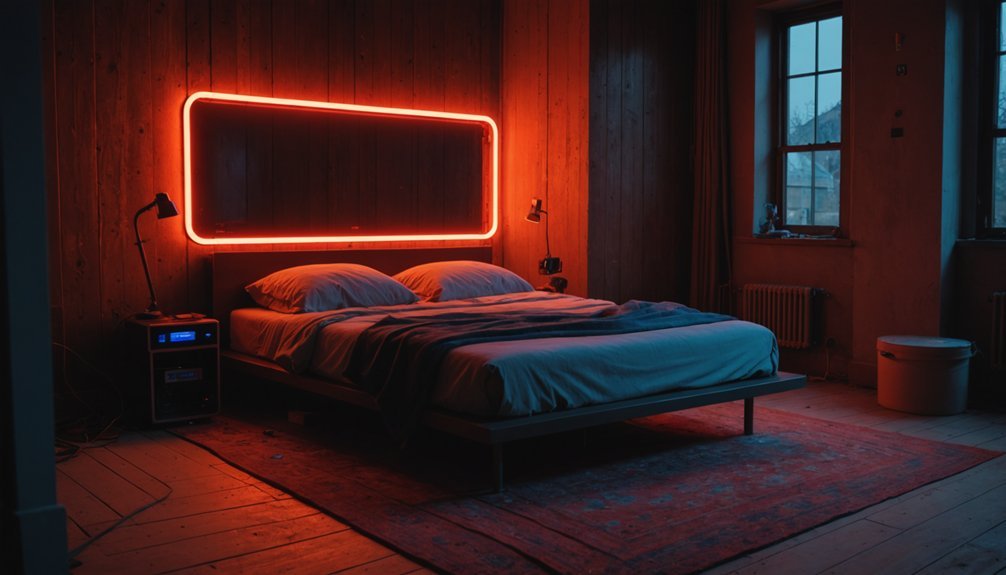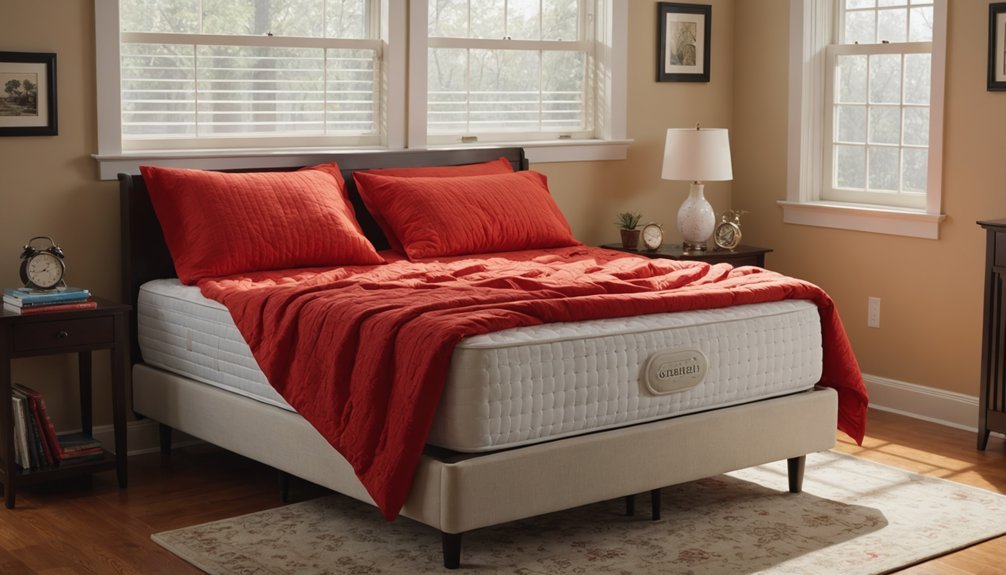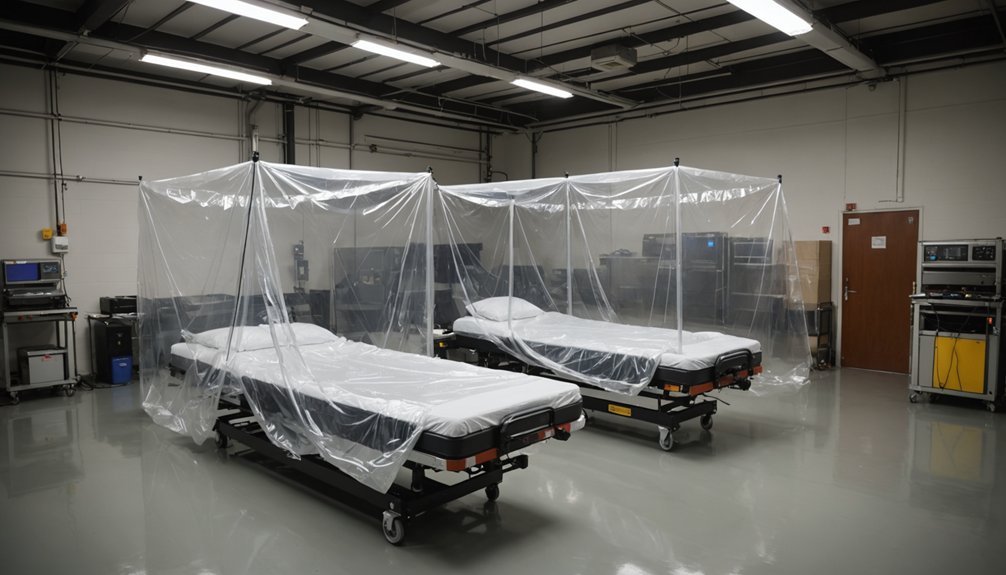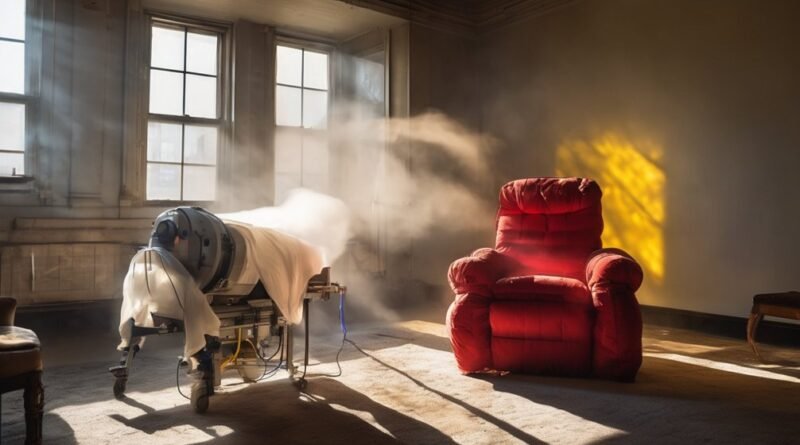Bed Bug Heat Treatment at Home: Does It Work?
If you’re battling bed bugs, you’ve likely heard that heat can kill these persistent pests. While it’s true that high temperatures can eliminate bed bugs effectively, achieving success isn’t as simple as cranking up your heater or running a few space heaters. The difference between partial and complete elimination often comes down to precise temperature control and proper heat distribution – factors that make many DIY attempts fall short of expectations.
Key Takeaways
- Heat treatment effectively kills bed bugs when temperatures reach 120-140°F, destroying cells and proteins across all life stages.
- Professional treatments are more reliable than DIY methods due to specialized equipment and expertise in temperature control.
- DIY heat treatments often fail because household heaters cannot maintain the required temperatures consistently throughout infested areas.
- Successful treatment requires maintaining at least 118°F for 90 minutes, which is difficult without professional-grade equipment.
- Heat treatment has a 95% success rate when done correctly, but improper application can lead to treatment failure.
Understanding the Science of Heat Treatment for Bed Bugs

When it comes to eliminating bed bugs, heat treatment stands out as one of the most effective solutions by exploiting these pests’ biological vulnerabilities. This method raises temperatures to levels that are lethal to bed bugs at all life stages, from eggs to adults. Moreover, the use of steamers and bed bug elimination can further enhance the effectiveness of heat treatment by targeting hard-to-reach areas where these pests may hide. This comprehensive approach ensures a thorough eradication, providing peace of mind to those dealing with infestations.
Since bed bugs are ectothermic, they can’t regulate their body temperature, making them highly susceptible to heat damage.
When you expose bed bugs to high temperatures, it triggers rapid cellular destruction in their bodies. The heat ruptures their cell membranes, denatures proteins, and causes severe dehydration. Maintaining temperatures between 120°F to 140°F ensures complete elimination of the infestation.
This process affects all life stages – from eggs to adults – preventing any chance of survival or reproduction. Even if some bugs don’t die immediately, sublethal heat exposure will weaken them by disrupting their feeding and development patterns.
You’ll find that heat treatment is particularly effective because it penetrates deep into furniture, carpets, and wall voids where bed bugs hide.
Required Temperatures and Time for Complete Elimination

The precise application of heat is key to successfully eliminating bed bugs from your home.
You’ll need to maintain temperatures of at least 118°F (48°C) for 90 minutes to kill both adult bugs and their eggs. If you can reach 122°F (50°C), you’ll achieve immediate mortality across all life stages.
For lower temperatures around 113°F (45°C), you’ll need to extend the treatment time to about 7 hours. Using powerful convection fans helps distribute the heat more effectively throughout the space.
While adult bed bugs may die after 15-20 minutes of exposure to temperatures between 113-118°F, it’s essential to maintain the heat longer to guarantee egg mortality and deep penetration into furniture and wall voids.
Professional treatments typically heat rooms to 135-140°F and maintain these temperatures for several hours to assure complete elimination.
Professional Vs DIY Heat Treatment Methods

Choosing between professional and DIY heat treatments for bed bugs involves weighing several critical factors. While professionals bring expertise and specialized equipment to guarantee thorough treatment, DIY methods offer cost savings and scheduling flexibility. You’ll need to take into account your budget, time constraints, and comfort level with managing complex equipment. Follow-up inspections are often included in professional service packages for better long-term results.
| Aspect | Professional | DIY |
|---|---|---|
| Cost | $1,300+ per treatment | High upfront equipment cost |
| Effectiveness | Consistent heat distribution | Variable results |
| Time Investment | Minimal personal labor | Significant prep and monitoring |
Professional services typically complete treatments faster and provide guarantees, but you’ll pay premium prices. If you’re willing to invest time learning proper techniques, DIY treatments can be cost-effective, especially for recurring issues. However, you’ll need to carefully monitor temperatures and guarantee complete coverage to achieve successful results.
Essential Equipment and Safety Considerations
You’ll need specific heat treatment equipment including electric or propane heaters, infrared temperature guns, and air movers to effectively eliminate bed bugs.
Professional-grade equipment is essential since standard household heaters cannot reach the required temperatures for effective treatment.
It’s essential to maintain continuous temperature monitoring between 130-160°F while following strict safety protocols for fire prevention and proper ventilation.
Your success depends on using the right monitoring tools, from digital thermostats to wireless sensors, to guarantee every corner of the treated space reaches and maintains lethal temperatures.
Professional Equipment Requirements
Professional bed bug heat treatment demands specialized equipment that’s both powerful and precise to achieve successful eradication.
You’ll need industrial-grade heaters capable of reaching 135°F, along with multiple thermometers to monitor temperatures throughout the space. These units must deliver at least 26,000 BTU and connect to adequate power sources, often requiring 45+ amp circuits. Professional units like the BBHD-8 use 240-volt PTAC circuits for reliable power delivery.
You’ll also need a combination of oscillating and box fans to distribute heat evenly, preventing cold spots where bed bugs might survive.
Essential monitoring equipment includes infrared temperature guns and remote sensors to track heat levels in hard-to-reach areas.
Don’t forget proper extension cords rated for heavy loads and insulating materials to seal windows and vents, ensuring the heated air stays contained during treatment.
Avoiding Common Safety Hazards
While proper equipment enables effective heat treatment, safety must remain the top priority throughout the process.
You’ll need to remove all flammable items, including aerosol cans, candles, and combustible liquids before starting. Unplug and remove heat-sensitive electronics, or protect them with thermal blankets. Don’t forget to relocate your plants and pets to safety.
Avoid using DIY heaters like torpedo heaters, as they create uneven heating and fire risks. Instead, rely on professional equipment designed for even heat distribution.
Disconnect all electrical devices from power sources to prevent short circuits. After treatment, ventilate the area thoroughly to clear any off-gassing from heated materials.
Don’t re-enter until the space has properly cooled down to avoid heat exhaustion or respiratory issues.
Temperature Monitoring Tools
Accurate temperature monitoring stands at the heart of successful bed bug heat treatment.
You’ll need wireless digital sensors that can track temperatures in real-time, especially in critical spots like mattresses, furniture joints, and wall voids. These sensors should detect temperatures between 120°F and 140°F – the lethal range for bed bugs.
For thorough coverage, you’ll want multiple sensors connected to a central monitoring system.
This setup lets you track temperatures via smartphone apps and receive instant alerts if temperatures drop below effective levels. Look for sensors with long battery life and proper calibration standards.
Remember to place them strategically to identify cold spots where bed bugs might survive.
Most modern systems also log data, which helps verify that lethal temperatures were maintained throughout the treatment process.
Common Mistakes to Avoid During Heat Treatment
Successful bed bug heat treatments require careful planning and execution, yet many homeowners and technicians make preventable mistakes that compromise their effectiveness.
You’ll risk treatment failure if you’re using inadequate heating equipment for your space or not monitoring temperatures properly.
Don’t rush the process – thorough treatments often take longer than 4 hours. Moving furniture or belongings before inspection can spread bed bugs to new areas.
Pay attention to structural challenges like concrete floors and poor airflow. Keep doors and drawers open, and guarantee heat penetrates all hiding spots.
Don’t forget to turn off AC units and close windows. Most importantly, don’t skip proper preparation or post-treatment inspections.
If you’re hiring professionals, verify they’re using certified technicians who understand bed bug behavior and treatment requirements.
Measuring Success: Signs of an Effective Treatment
To guarantee your bed bug heat treatment achieved its goal, you’ll need to look for specific indicators of success.
Look for dead bed bugs and shed exoskeletons as immediate evidence that the heat reached lethal levels. You’ll want to confirm that temperatures maintained at least 113°F (45°C) for 90 minutes throughout the treated space.
Dead bed bugs and shed exoskeletons provide proof of successful heat treatment, confirming lethal temperatures were maintained throughout the space.
Watch for a significant decrease in bed bug activity over the following weeks. You shouldn’t see any new bites, rust-colored stains, or live bugs.
Set up bed bug interceptors to monitor for surviving insects, and conduct thorough inspections 1-2 weeks after treatment. If you’ve done everything correctly, you can expect a success rate of over 95%.
Conclusion
While you can attempt DIY bed bug heat treatment at home, you’re likely to achieve better results with professional services. If you decide to tackle it yourself, make sure you’ve got proper temperature monitoring equipment and maintain consistent heat levels throughout the space. Remember, success depends on reaching 120°F-140°F in all hiding spots. Whatever method you choose, thorough preparation and careful execution are essential for effective bed bug elimination.

